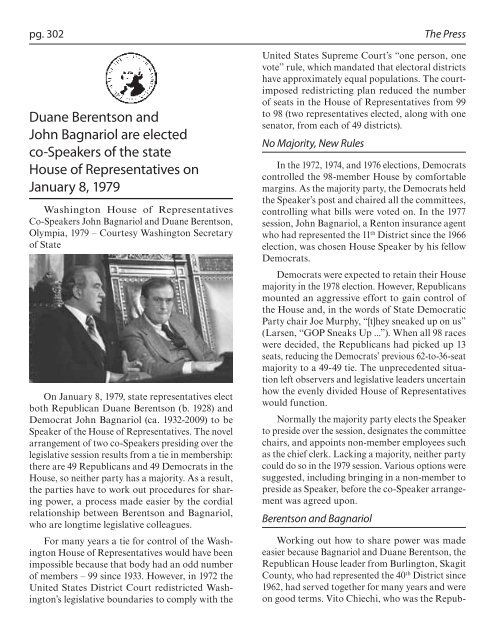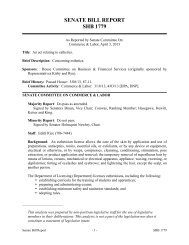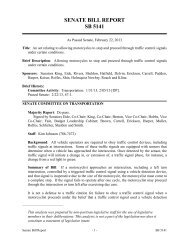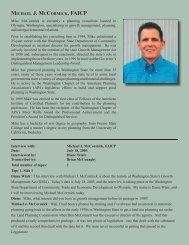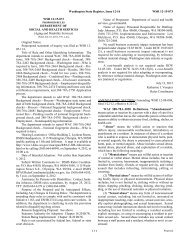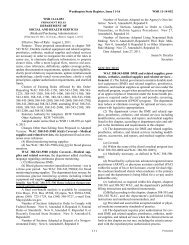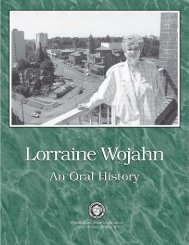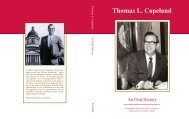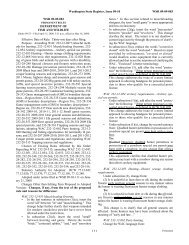Helen Sommers: An Oral History
Helen Sommers: An Oral History
Helen Sommers: An Oral History
Create successful ePaper yourself
Turn your PDF publications into a flip-book with our unique Google optimized e-Paper software.
pg. 302 The Press<br />
Duane Berentson and<br />
John Bagnariol are elected<br />
co-Speakers of the state<br />
House of Representatives on<br />
January 8, 1979<br />
Washington House of Representatives<br />
Co-Speakers John Bagnariol and Duane Berentson,<br />
Olympia, 1979 – Courtesy Washington Secretary<br />
of State<br />
On January 8, 1979, state representatives elect<br />
both Republican Duane Berentson (b. 1928) and<br />
Democrat John Bagnariol (ca. 1932-2009) to be<br />
Speaker of the House of Representatives. The novel<br />
arrangement of two co-Speakers presiding over the<br />
legislative session results from a tie in membership:<br />
there are 49 Republicans and 49 Democrats in the<br />
House, so neither party has a majority. As a result,<br />
the parties have to work out procedures for sharing<br />
power, a process made easier by the cordial<br />
relationship between Berentson and Bagnariol,<br />
who are longtime legislative colleagues.<br />
For many years a tie for control of the Washington<br />
House of Representatives would have been<br />
impossible because that body had an odd number<br />
of members – 99 since 1933. However, in 1972 the<br />
United States District Court redistricted Washington’s<br />
legislative boundaries to comply with the<br />
United States Supreme Court’s “one person, one<br />
vote” rule, which mandated that electoral districts<br />
have approximately equal populations. The courtimposed<br />
redistricting plan reduced the number<br />
of seats in the House of Representatives from 99<br />
to 98 (two representatives elected, along with one<br />
senator, from each of 49 districts).<br />
No Majority, New Rules<br />
In the 1972, 1974, and 1976 elections, Democrats<br />
controlled the 98-member House by comfortable<br />
margins. As the majority party, the Democrats held<br />
the Speaker’s post and chaired all the committees,<br />
controlling what bills were voted on. In the 1977<br />
session, John Bagnariol, a Renton insurance agent<br />
who had represented the 11 th District since the 1966<br />
election, was chosen House Speaker by his fellow<br />
Democrats.<br />
Democrats were expected to retain their House<br />
majority in the 1978 election. However, Republicans<br />
mounted an aggressive effort to gain control of<br />
the House and, in the words of State Democratic<br />
Party chair Joe Murphy, “[t]hey sneaked up on us”<br />
(Larsen, “GOP Sneaks Up ...”). When all 98 races<br />
were decided, the Republicans had picked up 13<br />
seats, reducing the Democrats’ previous 62-to-36-seat<br />
majority to a 49-49 tie. The unprecedented situation<br />
left observers and legislative leaders uncertain<br />
how the evenly divided House of Representatives<br />
would function.<br />
Normally the majority party elects the Speaker<br />
to preside over the session, designates the committee<br />
chairs, and appoints non-member employees such<br />
as the chief clerk. Lacking a majority, neither party<br />
could do so in the 1979 session. Various options were<br />
suggested, including bringing in a non-member to<br />
preside as Speaker, before the co-Speaker arrangement<br />
was agreed upon.<br />
Berentson and Bagnariol<br />
Working out how to share power was made<br />
easier because Bagnariol and Duane Berentson, the<br />
Republican House leader from Burlington, Skagit<br />
County, who had represented the 40 th District since<br />
1962, had served together for many years and were<br />
on good terms. Vito Chiechi, who was the Repub-


